Preparation of Micro-Size Spherical Silver Particles and Their Application in Conductive Silver Paste
Abstract
:1. Introduction
2. Materials and Methods
2.1. Materials
2.2. Preparation of Silver Particles
2.3. Characterization
3. Results and Discussion
3.1. Characterization of the Synthetic Silver Particles
3.2. Effects of Experimental Condition on Morphology and Particle Size of Silver Particles
3.2.1. Effect of Dispersant
3.2.2. Effect of pH Values
3.2.3. Effect of Stirring Speed
3.3. Possible Formation Mechanism of Spherical Silver Particles
3.4. Resistivity of Silver Paste
4. Conclusions
Author Contributions
Funding
Institutional Review Board Statement
Informed Consent Statement
Data Availability Statement
Conflicts of Interest
References
- Lee, K.J.; Jun, B.H.; Choi, J.R.; Lee, Y.I.; Joung, J.; Oh, Y. Environmentally friendly synthesis of organic-soluble silver nanoparticles for printed electronics. Nanotechnology 2007, 18, 335601–335605. [Google Scholar] [CrossRef]
- Cano-Raya, C.; Denchev, Z.Z.; Cruz, S.F.; Viana, J.C. Chemistry of solid metal-based inks and pastes for printed electronics—A review. Appl. Mater. Today 2019, 15, 416–430. [Google Scholar] [CrossRef]
- Derakhshankhah, H.; Mohammad-Rezaei, R.; Massoumi, B.; Abbasian, M.; Rezaei, A.; Samadian, H.; Jaymand, M. Conducting polymer-based electrically conductive adhesive materials: Design, fabrication, properties, and applications. J. Mater. Sci. Mater. Electron. 2020, 31, 10947–10961. [Google Scholar] [CrossRef]
- Aradhana, R.; Mohanty, S.; Nayak, S.K. A review on epoxy-based electrically conductive adhesives. Int. J. Adhes. Adhes. 2020, 99, 102596. [Google Scholar] [CrossRef]
- Cheng, Y.; Zhang, J.; Fang, C.; Qiu, W.; Chen, H.; Liu, H.; Wei, Y. Preparation of Low Volatile Organic Compounds Silver Paste Containing Ternary Conductive Fillers and Optimization of Their Performances. Molecules 2022, 27, 8030. [Google Scholar] [CrossRef] [PubMed]
- Tsai, J.T.; Lin, S.T. Silver powder effectiveness and mechanism of silver paste on silicon solar cells. J. Alloys Compd. 2013, 548, 105–109. [Google Scholar] [CrossRef]
- Yang, M.; Chen, X.H.; Wang, Z.D.; Zhu, Y.Z.; Pan, S.W.; Chen, K.X.; Wang, Y.L.; Zheng, J.Q. Zero→Two-Dimensional Metal Nanostructures: An Overview on Methods of Preparation, Characterization, Properties, and Applications. Nanomaterials 2021, 11, 1895. [Google Scholar] [CrossRef] [PubMed]
- Koo, H.Y.; Yi, J.H.; Kim, J.H.; Ko, Y.N.; Jung, Y.N.; Kang, Y.C.; Lee, J.H. Conductive silver films formed from nano-sized silver powders prepared by flame spray pyrolysis. Mater. Chem. Phys. 2010, 124, 959–963. [Google Scholar] [CrossRef]
- Gan, W.; Pan, Q.; Zhang, J. Effect of Silver Powder for Back Silver Paste on Properties Of Crystalline Silicon Solar Cells. J. Gan Semicond. Optoelectron. 2014, 35, 1016. [Google Scholar] [CrossRef]
- Ye, X.Y.; Xiao, X.Q.; Zheng, C.; Hua, N.B.; Huang, Y.Y. Microemulsion-assisted hydrothermal synthesis of mesoporous silver/titania composites with enhanced infrared radiation performance. Mater. Lett. 2015, 152, 237–239. [Google Scholar] [CrossRef]
- Lai, Y.B.; Guo, Z.C.; Huang, H.; Zhang, H.Y.; Wang, S. Synthesis of Monodisperse Micrometer-sized Spherical Silver Particles. J. Mater. Sci. Technol. 2014, 32, 221. [Google Scholar] [CrossRef]
- Prozorova, G.F.; Korzhova, S.A.; Kon’kova, T.; Ermakova, T.G.; Pozdnyakov, A.S.; Sukhov, B.G.; Arsentyev, K.Y.; Likhoshway, K.Y.; Trofimov, B.A. Specific features of formation of silver nanoparticles in the polymer matrix. Dokl. Chem. 2011, 437, 47–49. [Google Scholar] [CrossRef]
- Fadli, A.L.; Hanifah, A.; Fitriani, A.; Rakhmawati, A.; Dwandaru, W. Application of silver-chitosan nanoparticles as a prevention and eradication of nosocomial infections due to Staphylococcus aureus sp. In AIP Conference Proceedings; AIP Publishing LLC: Long Island, NY, USA, 2018. [Google Scholar] [CrossRef]
- Haider, A.; Kang, I.K. Preparation of Silver Nanoparticles and Their Industrial and Biomedical Applications: A Comprehensive Review. Mater. Sci. Eng. A 2015, 2015, 16. [Google Scholar] [CrossRef] [Green Version]
- Venkatesham, M.; Ayodhya, D.; Madhusudhan, A.; Babu, N.V.; Veerabhadram, G. A novel green one-step synthesis of silver nanoparticles using chitosan: Catalytic activity and antimicrobial studies. Appl. Nanosci. 2014, 4, 113–119. [Google Scholar] [CrossRef] [Green Version]
- Guo, G.Q.; Gan, W.P.; Luo, J.A.; Xiang, F.; Zhang, J.L.; Zhou, H.; Liu, H.A. Preparation and dispersive mechanism of highly dispersive ultrafine silver powder. Appl. Surf. Sci. 2010, 256, 6683–6687. [Google Scholar] [CrossRef]
- Gan, W.; Luo, J.; Guo, G.; Xiang, F.; Liu, H. Preparation of ultra-fine silver powder used in electronic paste by chemical reduction. J. Electron. Mater. 2010, 29, 15–18. [Google Scholar] [CrossRef]
- Qin, Y.Q.; Ji, X.H.; Jing, J.; Liu, H.; Wu, H.L.; Yang, W.S. Size control over spherical silver nanoparticles by ascorbic acid reduction. Colloids Surf. A Physicochem. Eng. Asp. 2010, 372, 172–176. [Google Scholar] [CrossRef]
- An, B.; Cai, X.H.; Wu, F.S.; Wu, Y.P. Preparation of micro-sized and uniform spherical Ag powders by novel wet-chemical method. T. Nonferr. Metal. Soc. 2020, 20, 1550–1554. [Google Scholar] [CrossRef]
- Xie, W.; Zheng, Y.Y.; Kuang, J.C.; Wang, Z.; Yi, S.H.; Deng, Y.J. Preparation of Disperse Silver Particles by Chemical Reduction. Russ. J. Phys. Chem. 2016, 90, 848–855. [Google Scholar] [CrossRef]
- Tan, F.; Wang, H.; Wang, W.; Chen, J.; Qiao, X. Morphology and size control of spherical conductive silver particles. J. Electron. Mater. 2011, 30, 52. [Google Scholar] [CrossRef]
- Cai, X.H.; Chen, X.C.; An, B.; Wu, F.S.; Wu, Y.P. The effects of bonding parameters on the reliability performance of flexible RFID tag inlays packaged by anisotropic conductive adhesive. In Proceedings of the 2009 International Conference on Electronic Packaging Technology & High Density Packaging, Beijing, China, 10–13 August 2009. [Google Scholar] [CrossRef]
- Sannohe, K.; Ma, T.L.; Hayase, S. Synthesis of monodispersed silver particles: Synthetic techniques to control shapes, particle size distribution and lightness of silver particles. Adv. Powder Technol. 2019, 30, 3088–3098. [Google Scholar] [CrossRef]
- Liu, C.; Fu, Q.; Zou, J.; Huang, Y.; Zeng, X.; Cheng, B. Effects of polyester resin molecular weight on the performance of low temperature curing silver pastes. J. Mater. Sci. Mater. Electron. 2016, 27, 6511–6516. [Google Scholar] [CrossRef]
- Tian, Q.H.; Deng, D.; Li, Y.; Guo, X.Y. Preparation of ultrafine silver powders with controllable size and morphology. T. Nonferr. Metal Soc. 2018, 28, 524–533. [Google Scholar] [CrossRef]
- Ajitha, B.; Ashok, K.; Reddy, P.S. Enhanced antimicrobial activity of silver nanoparticles with controlled particle size by pH variation. Powder Technol. 2015, 269, 110–117. [Google Scholar] [CrossRef]
- Bai, X.H.; Li, W.; Du, X.S.; Zhang, P.; Lin, Z.D. Synthesis of spherical silver particles with micro/nanostructures at room temperature-ScienceDirec. Compos. Commun. 2017, 4, 54–58. [Google Scholar] [CrossRef]
- Gu, S.; Wei, W.; Hui, W.; Tan, F.; Qiao, X. Effect of aqueous ammonia addition on the morphology and size of silver particles reduced by ascorbic acid. J. Chem. Pow. Technol. 2013, 233, 91–95. [Google Scholar] [CrossRef]
- Li, Y.F.; Gan, W.P.; Liu, X.G.; Lin, T.; Huang, B. Dispersion mechanisms of Arabic gum in the preparation of ultrafine silver powder. Korean. J. Chem. Eng. 2014, 31, 1490–1495. [Google Scholar] [CrossRef]
- Deng, D.; Huang, C.; Ma, J.; Bai, S. Reducing resistance and curing temperature of silver pastes containing nanowires. J. Mater. Sci. Mater. Electron. 2018, 29, 10834–10840. [Google Scholar] [CrossRef]
- Huang, W.W.; Qiu, H.J.; Zhang, Y.Q.; Zhang, F.; Gao, L.; Omran, M.; Chen, G. Microstructure and phase transformation behavior of Al2O3-ZrO2 under microwave sintering. Ceram. Int. 2022, 49, 4855–4862. [Google Scholar] [CrossRef]
- Park, K.J.; Seo, D.S.; Lee, J.K. Conductivity of silver paste prepared from nanoparticles. Colloids Surf. A-Physicochem. Eng. Aspects. 2008, 313, 351–354. [Google Scholar] [CrossRef]
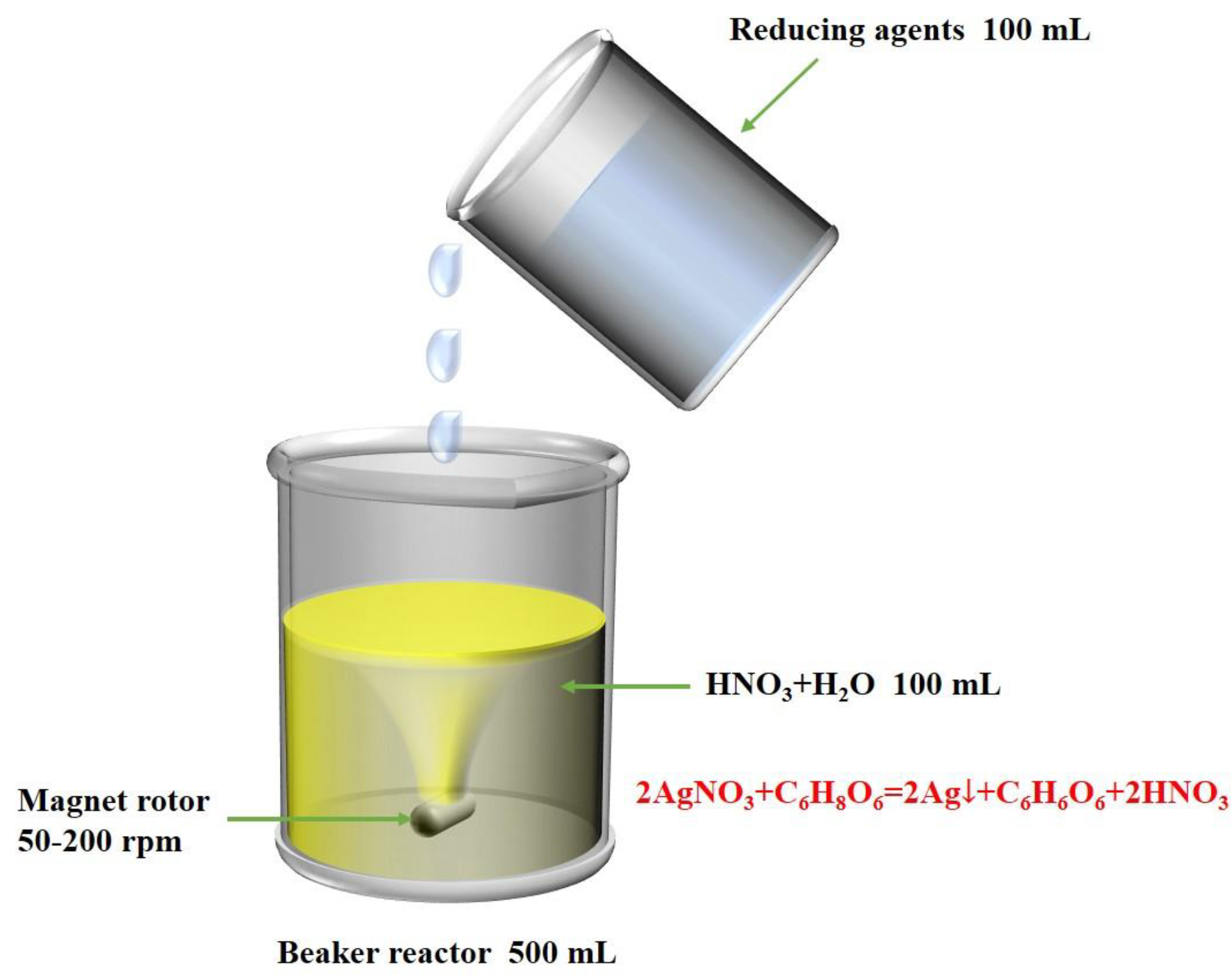

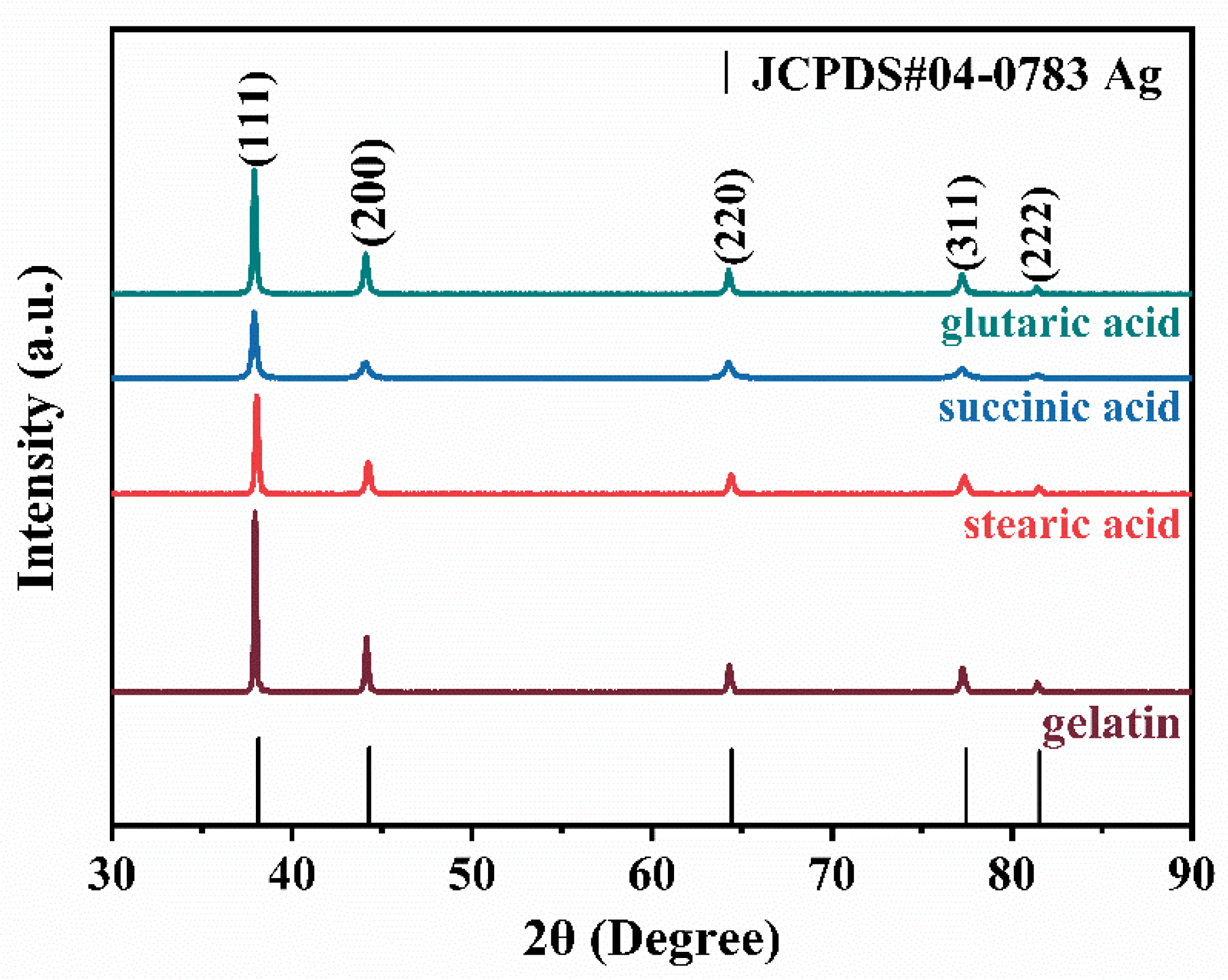
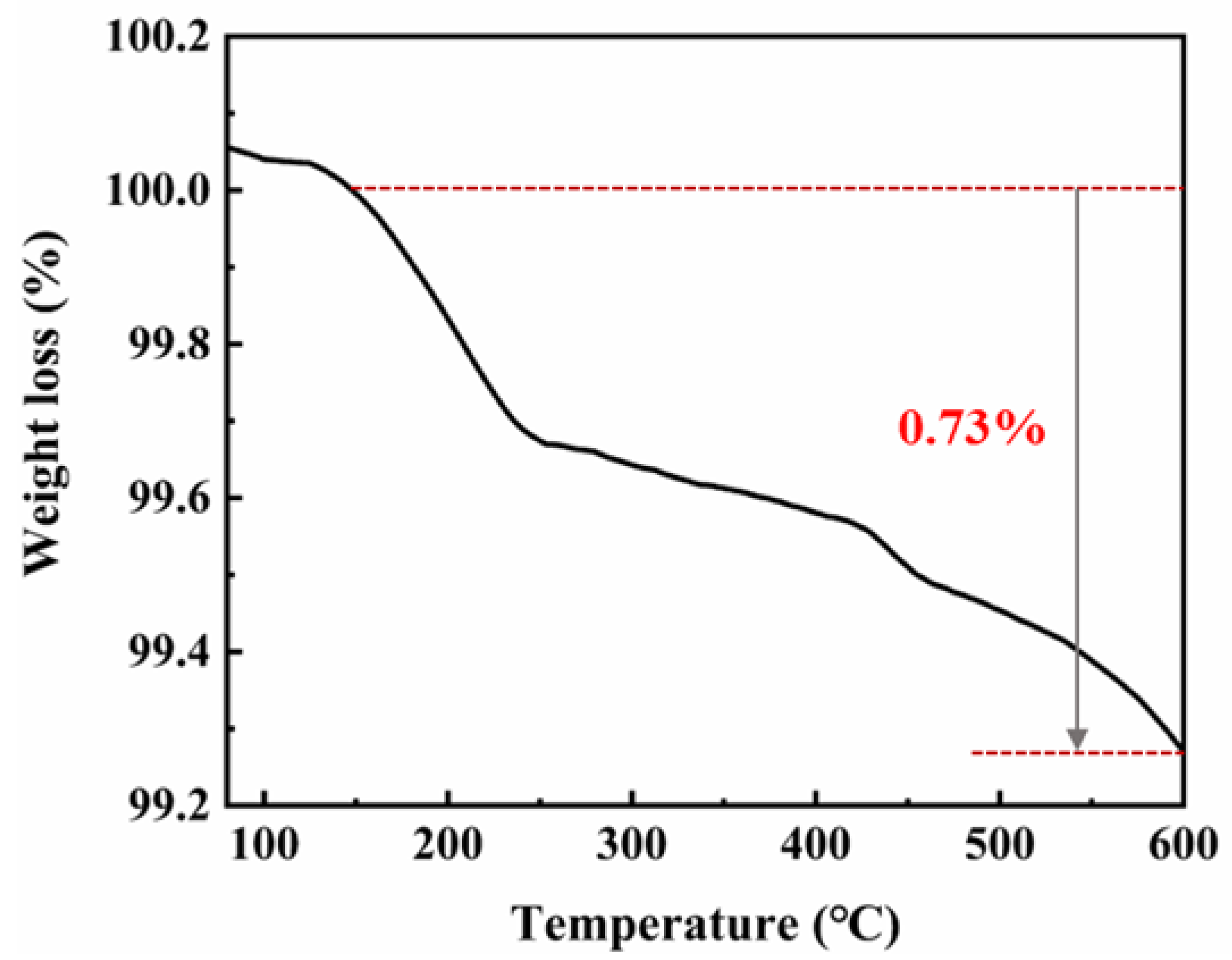

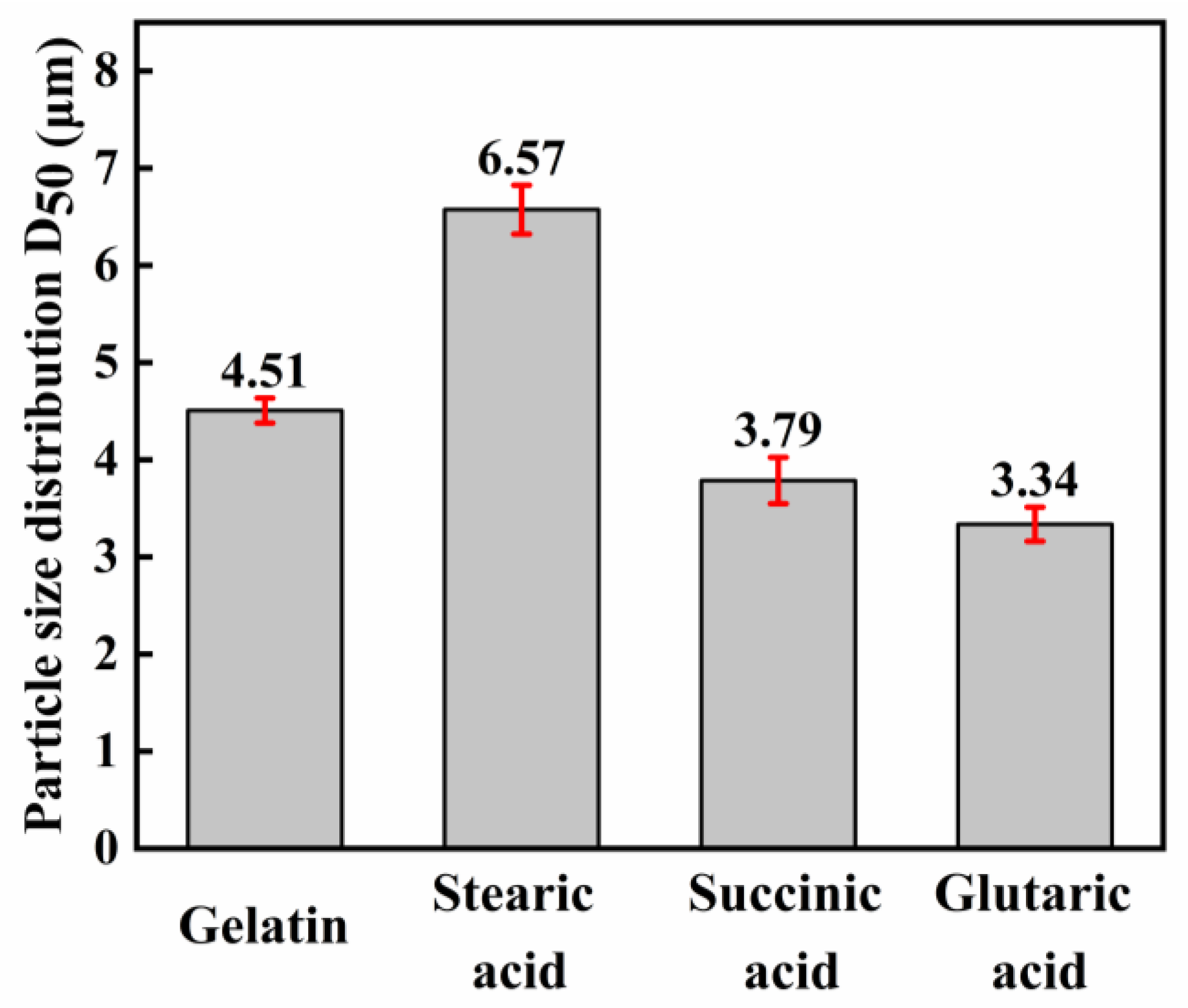
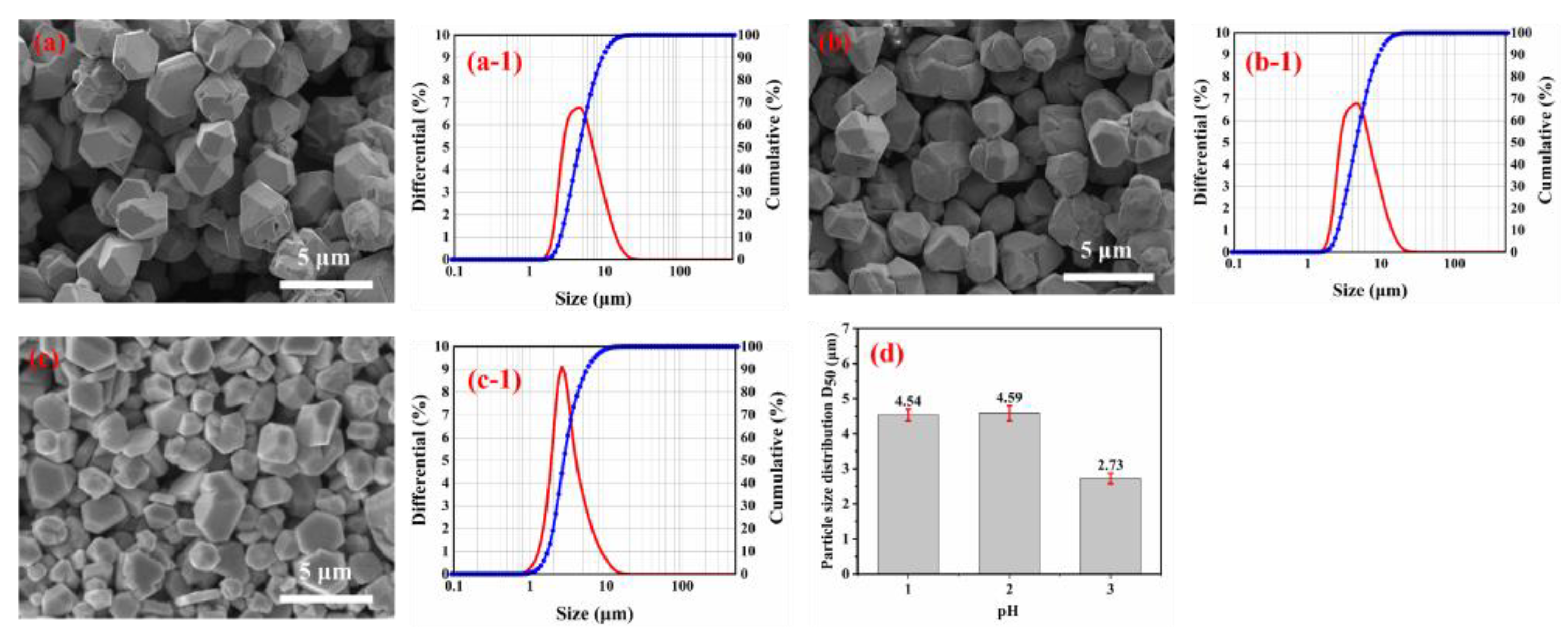
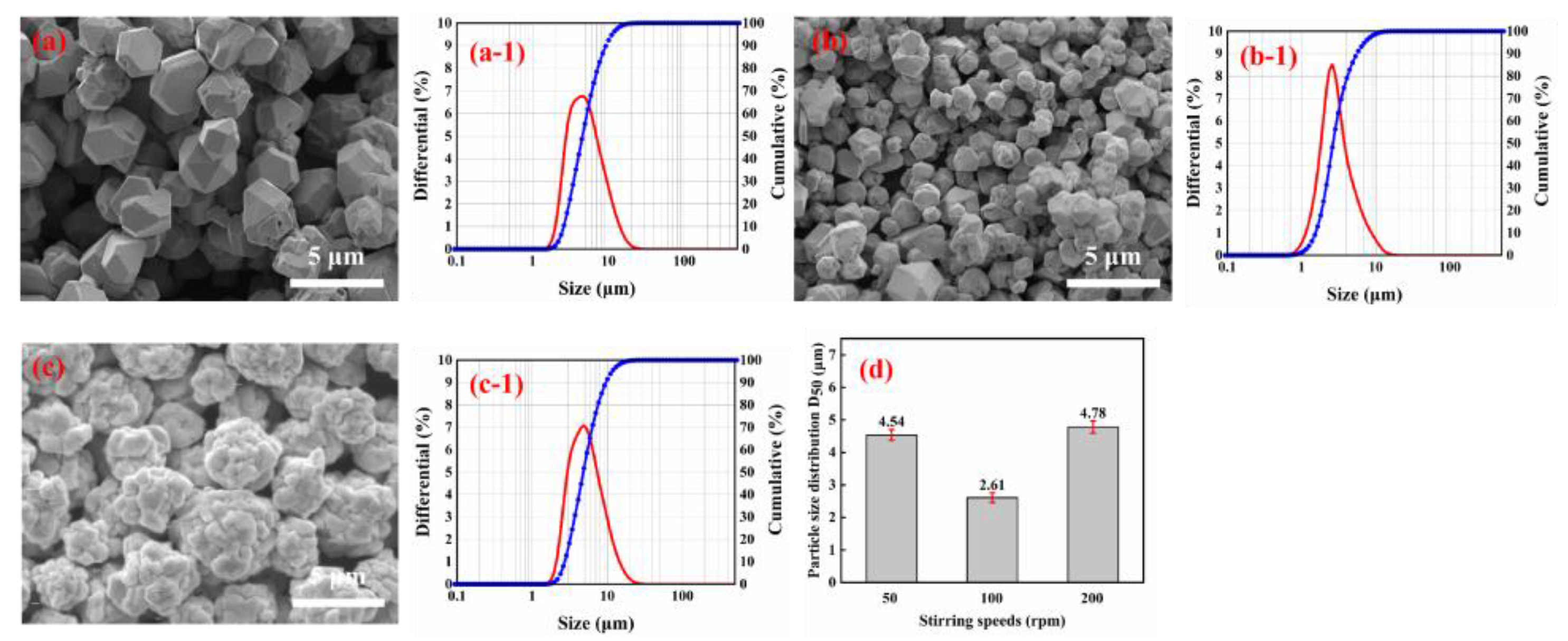


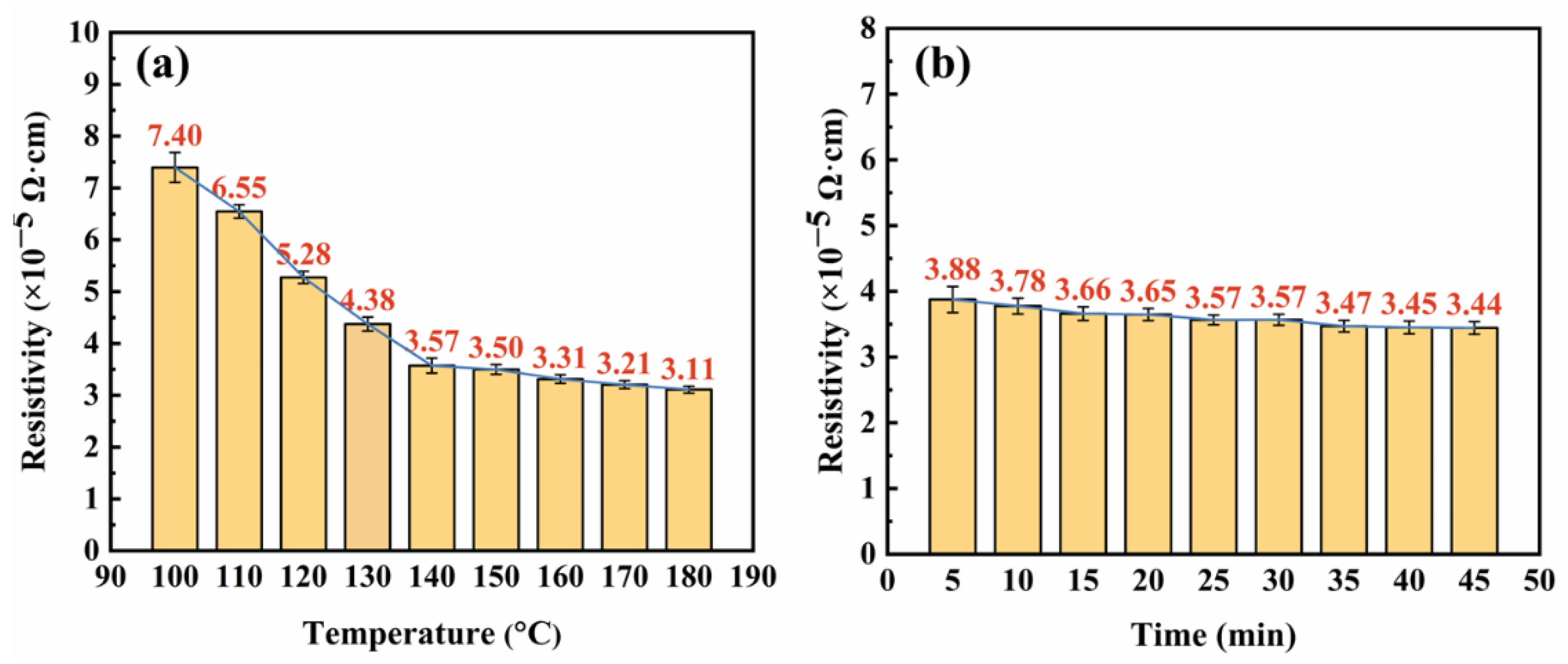
| Materials | Chemical Formula | Specification |
|---|---|---|
| Silver nitrate | AgNO3 | ≥99.8% |
| Ascorbic acid | C6H8O6 | ≥99.7% |
| Nitric acid | HNO3 | 98% |
| Absolute ethanol | C2H6O | 95% |
| Gelatin | — | Industrial-grade |
| Stearic acid | C18H36O2 | Analytical Reagent |
| succinic acid | C4H6O4 | Analytical Reagent |
| glutaric acid | C5H8O4 | Analytical Reagent |
| Notations | Length (mm) | Width (mm) | Thickness (μm) | Resistance (Ω) | Resistivity (Ω·cm) |
|---|---|---|---|---|---|
| Line 1 | 100 | 10 | 6.7 | 5.42 | 3.63 × 10−5 |
| Line 2 | 1500 | 0.3 | 6.3 | 2777.78 | 3.58 × 10−5 |
| Line 3 | 1500 | 0.4 | 5.6 | 2 343.75 | 3.50 × 10−5 |
Disclaimer/Publisher’s Note: The statements, opinions and data contained in all publications are solely those of the individual author(s) and contributor(s) and not of MDPI and/or the editor(s). MDPI and/or the editor(s) disclaim responsibility for any injury to people or property resulting from any ideas, methods, instructions or products referred to in the content. |
© 2023 by the authors. Licensee MDPI, Basel, Switzerland. This article is an open access article distributed under the terms and conditions of the Creative Commons Attribution (CC BY) license (https://creativecommons.org/licenses/by/4.0/).
Share and Cite
Li, N.; Li, J.; Wan, X.; Niu, Y.; Gu, Y.; Chen, G.; Ju, S. Preparation of Micro-Size Spherical Silver Particles and Their Application in Conductive Silver Paste. Materials 2023, 16, 1733. https://doi.org/10.3390/ma16041733
Li N, Li J, Wan X, Niu Y, Gu Y, Chen G, Ju S. Preparation of Micro-Size Spherical Silver Particles and Their Application in Conductive Silver Paste. Materials. 2023; 16(4):1733. https://doi.org/10.3390/ma16041733
Chicago/Turabian StyleLi, Na, Jun Li, Xiaoxi Wan, Yifan Niu, Yongwan Gu, Guo Chen, and Shaohua Ju. 2023. "Preparation of Micro-Size Spherical Silver Particles and Their Application in Conductive Silver Paste" Materials 16, no. 4: 1733. https://doi.org/10.3390/ma16041733




